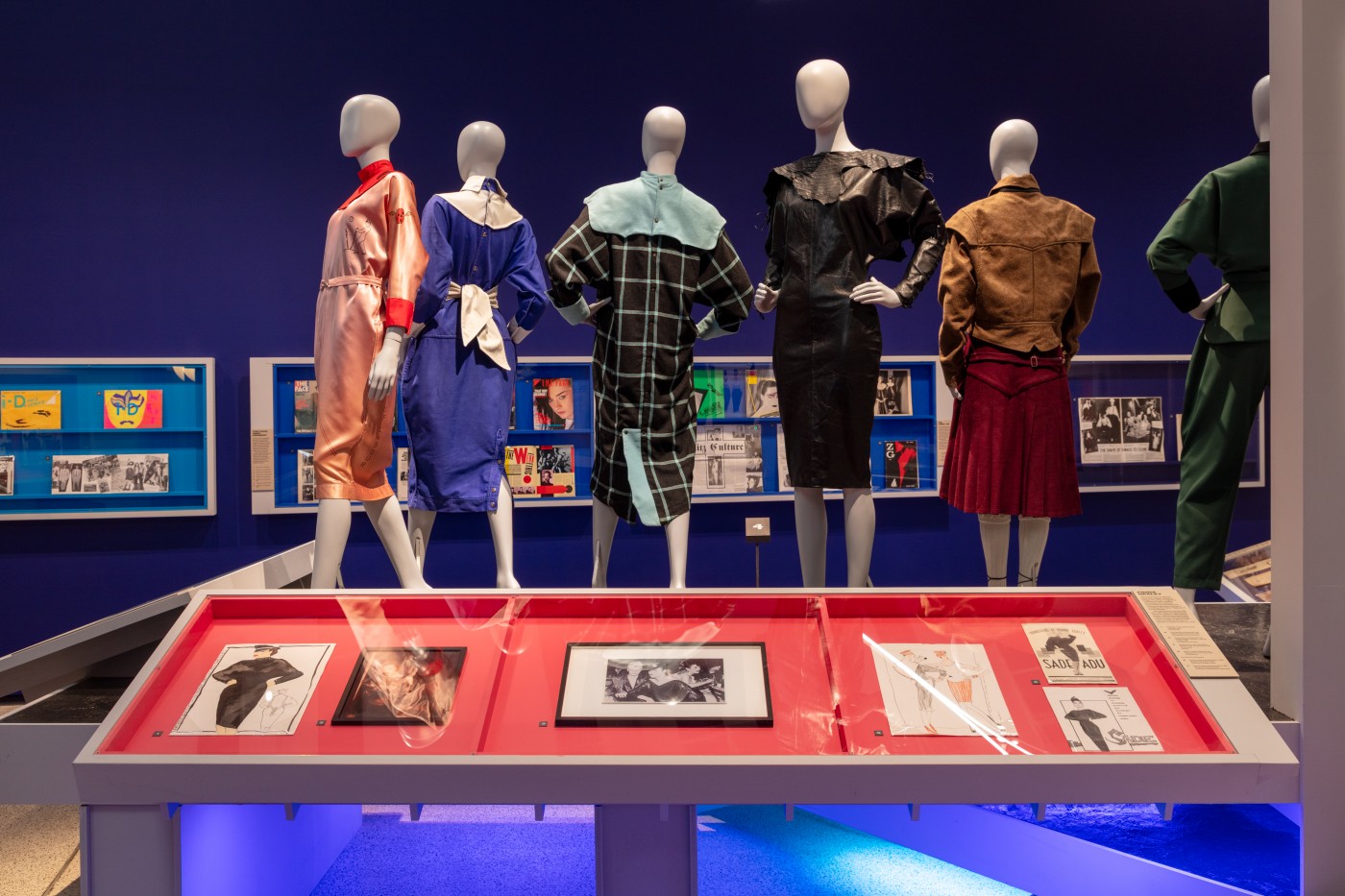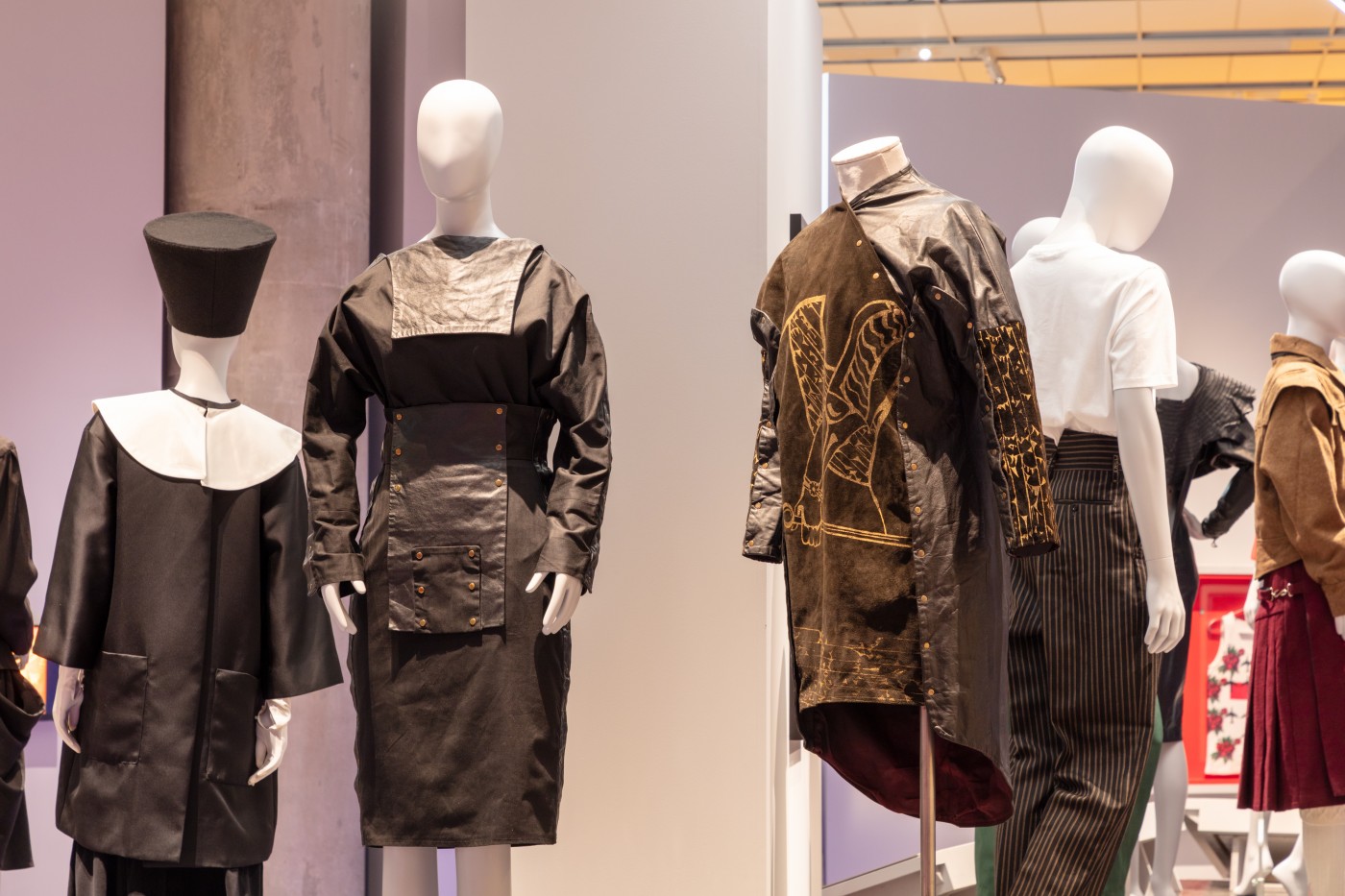- youtube
- bluesky
- Home
- About
- Costume Journal
- Membership
- Conference & Events
- Grants & Awards
- News & Social
In this week’s Costume Society blog knitwear designer and fashion academic Carolyn Clewer reviews the Design Museum exhibition BLITZ: the club that shaped the 80s.
The current Design Museum exhibition ‘BLITZ: the club that shaped the 80s’ is a fun and super-inspiring step back in time to late 70s and early 80s London club life. The key focus is on the huge cultural impact made by a small bunch of young creatives who hung out and posed about in the Blitz bar on a Tuesday night in Covent Garden for 18 months between 1979 and 1980. This new wave of young Londoners were looking for an escape from the reality of messy squats and rising unemployment, somewhere to be theatrical and exciting, tuning into jumble sale glamour, Bowie, Roxy Music, and art school ideas. Almost all the regulars went on to become influential and famous in music, fashion, journalism, art and design. Immediately the wider British media latched onto these ‘New Romantics’, fascinated and excited by the creators of extreme fashion looks, music and design and just as suddenly the Blitz Kids themselves became the new media and led creativity into the 80s.
I was not quite old enough to be a part of the Blitz, it wasn’t until 1982 that I started art school aged 16, but well before then I had caught onto the zeitgeist without really knowing what it was, spotting odd things in magazines and newspapers, dressing up, wandering along the Kings Road, making looks and tuning into an exciting, style-obsessed, creative world. The early 80s was a magical time for new ideas and fast change, led by youngtalented creatives, emerging from the exclusive, tight knit Blitz crowd and permeating into the mainstream via pop, fashion and media. As I entered the exhibition I heard ‘No GDM’ by Gina X and remembered buying the single at the market on the way to school- based purely on the cover image and instinct.

A selection of the iconic 80s style on show at the Blitz exhibition. Photograph: Luke Hayes
After punk became mainstream and commercialised, most of the UK was still pretty bleak boring and slow to change. The time was somehow right, and this new club night hosted by Steve Strange and Rusty Egan had a legendary door policy turning the night into a wild and competitive fashion event where only the strangest or strongest looks would make it into the club. This formed a community of the most imaginative and dressed-up creatives who became known as the ‘Blitz Kids’. The exhibition is arranged thematically and sometimes chronologically, but like real life it’s winding and enjoyably distracting, with blasts of music and many of the exhibits can be seen from different perspectives as you move through. You will discover work and stories about designers who grew out of the scene, many going on to impactful and long-lasting careers across fashion and other creative genres, maintaining connections and returning to work together.
There is strong focus on the importance of personal style and fashion, making connections between the designers, creatives and performers who formed the Blitz community. The creative crossovers and collaborations are apparent throughout the show- nothing is clear cut, people work together, share ideas and influences, dress each other, everything linked together, everything inspires something else. One of the strengths of the exhibitionis that most items have been lent from the personal collections of Blitz Kids and have not been shown in public before – the majority of items have not been seen for four decades.
There are display cases and mannequins of fashion and design pieces throughout the exhibition, starting with examples of second-hand finds, a mixture of discoveries from the time when you could still discover vintage treasures at an affordable price, all sourced from charity shops and surplus stores. Glamorous evening wear pieces from the past are displayed along with photos of them worn by Blitz-goers; for example, a fabulous 1950’s beaded cocktail dress and a dramatic ermine fur collar.
There is a recreation of the Blitz Club within the exhibition- something for the 2025 audience who want an immersive space and an Instagram moment. Visitors can photograph themselves against a video wall of recreatedclubbers, dance along to Blitz classics from a digitally rendered Rusty Egan in the dj booth or lean against the bar to watch archive footage of Spandau Ballet playing at the club. By chance the Blitz wine bar décor was wartime themed, perfect for the dressing-up-box poseurs. 1930s and 40s influences were especially important at the beginning of the Blitz story, as well as scouting vintage finds, these young fashion students anddesigners took inspiration from the past, reinventing silhouettes and detailing. Chris Sullivan, Blitz kid, performer and 80s clubland icon designed his own flashy purple tartan Zoot suit which became immortalised in photographs and now here on show, fully accessorised and with a magazine photoshoot.
Within the exhibition there are numerous garments by young fashion designers influenced by the Blitz scene- many that were probably made by the designers themselves. Seen close-up I love that a lot of the pieces have a slightly ‘fashion student’ feel about them- the opposite of mass produced or luxury fashion pieces that we associate with designer labels today. There is a charm and authenticity in being able to see the human touch in the wobble of a stitch or a screen- printed textile. Not exactly hand-craft, but more about a sense of urgency and being of the moment- the excitement of running up a creation to wear that moment or to sell in your shop the next day.
The community grew and started to sell, finding ways to make creativity into a career. Interesting to learn more about the first shops that stocked the new designers, like Axiom collective by Jon Baker: a TV interview clip shows him aged 20, explaining what makes his shop great and showing loyalty and respect to his designers, including a pair of trousers by singer Sade, a St Martins fashion graduate before she became a music megastar. Designers and labels that started as part of the niche scene and became more established, building on connections with customers, media and designers from within the ranks of Blitz before expanding into established names. So many connections and overlaps between disciplines, the fashion boutique Demob section shows a utilitarian top and culottes with a Sue Timney screen print (later of Timney and Fowler) and then carrier bags designed by Neville Brody, who reinvented graphic design for the 80s in The Face magazine.
The exhibition includes early editions of iconic publications like The Face, Blitz and i-D as well as loads of printed ephemera, magazines, flyers, packaging, photographs and personal mementoes from the era. There are some fantastic scraps of paper that have survived the decades, with scribbled or typed song lyrics and poems by unknowns who later became world famous. There are some beautiful examples of original 80’s fashion sketches, shown with rarely seen early works by designers including radical couture milliner Stephen Jones and Darla Jane Gilroy, now a fashion academic who was a nun-like character in David Bowie’s Ashes To Ashesmusic video- her ecclesiastical dress and collar is on display. An illustration of the pace of change and a sign of the Blitz impact: a year previously the club- goers had bonded over love of Bowie’s early music and then half of them pretended to ignore their hero when he visited the club in1980 to recruit Blitz Kids to appear in the most high-budget pop video of the time.
There is a lot to discover in the show: over 250 original artifacts, including fashion, accessories, but also photography, audio interviews with Blitz Kids that you can listen to on an old payphone, pop music, archive tv reports, videos and films. Whether you lived through it all or wish you had been there, you can’t deny the enduring influence of the Blitz.
The exhibition runs 20 September 2025–29 March 2026 at the Design Museum. Every Thursday, visitors who channel their inner New Romantic with Blitz club or 80s-inspired outfits receive a 20% discount on their tickets. Open until 20:00 every Saturday.
Exhibition Curator — Danielle Thom
Assistant Curator — Minnie Bates
With special thanks to Steve Dagger, Graham Ball and Fiona Dealey
About the Author
Carolyn Clewer is a knitwear designer, consultant and academic. Her work as partner in 'Paris Essex' is rooted in fashion, archive including knitwear and accessory collections, and collaborations including digitally designed, customised knitwear projects with Unmade Studio and capsule menswear knit collections for Wolsey.

A selection of the iconic 80s style on show at the Blitz exhibition. Photograph: Luke Hayes